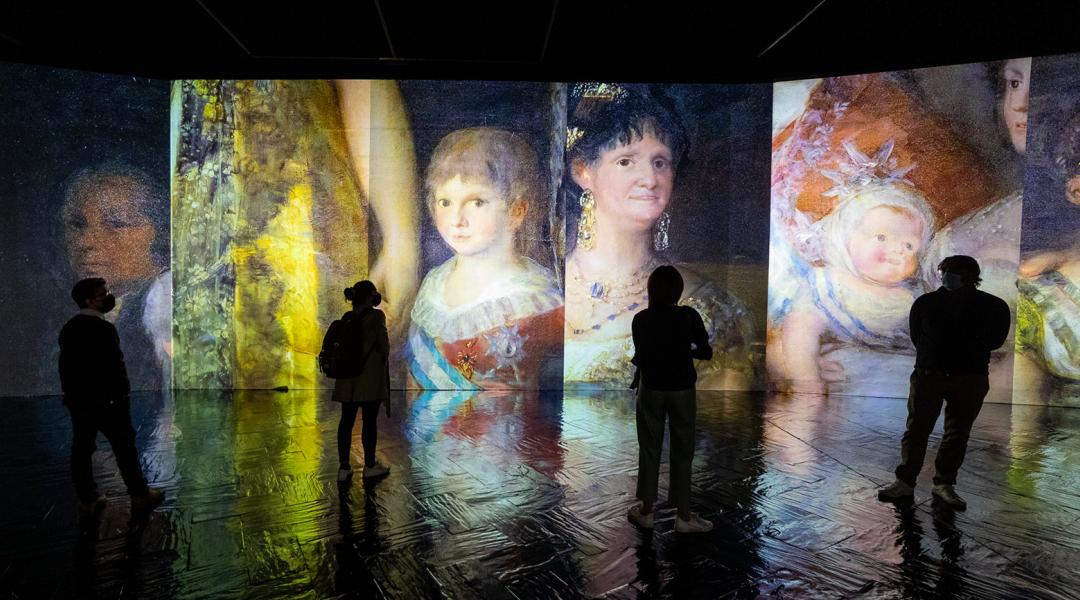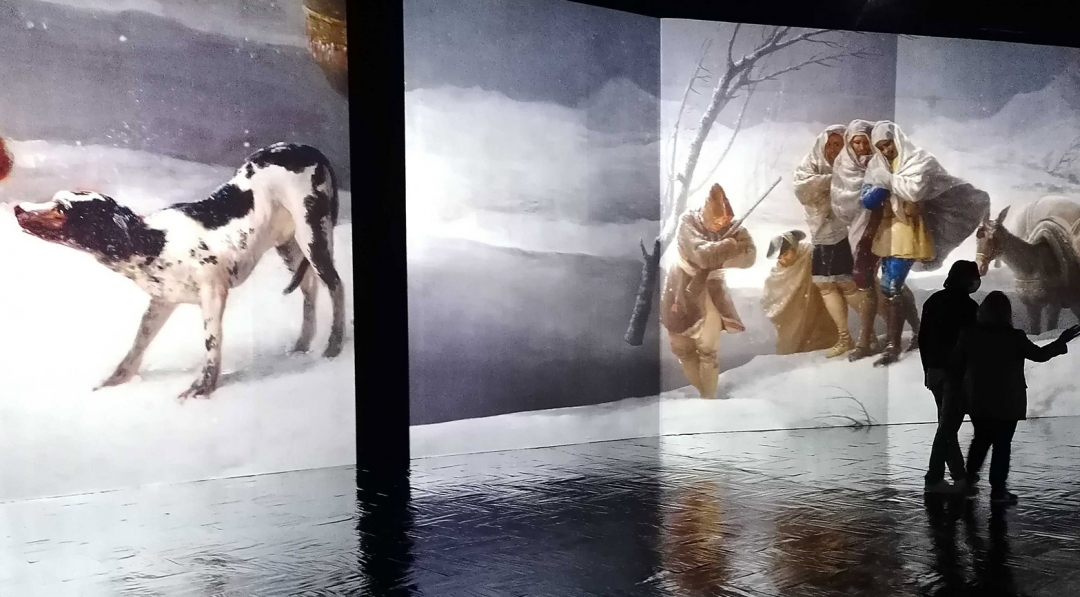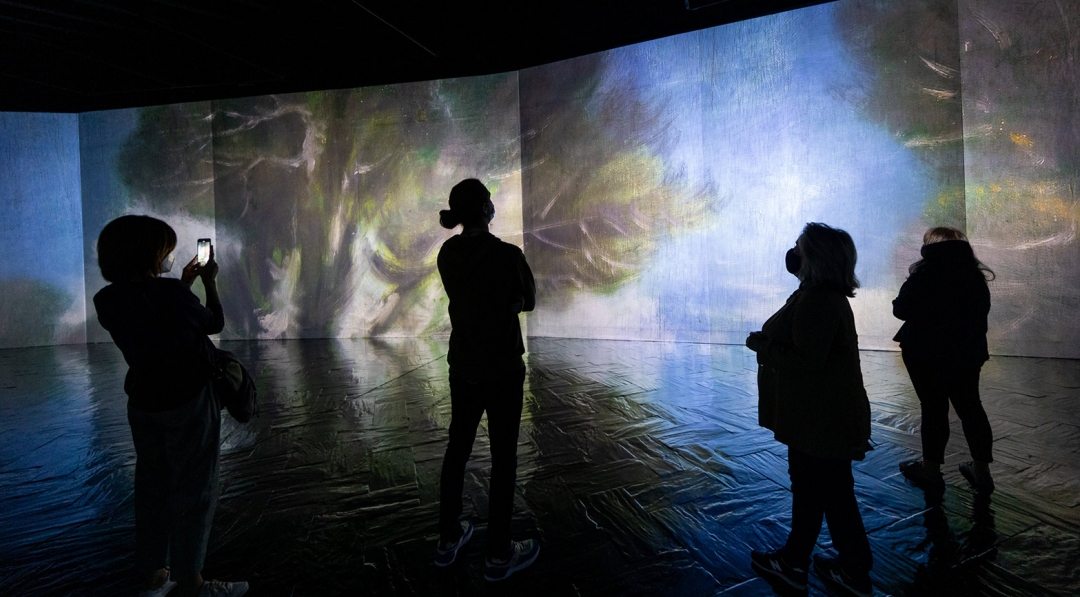INGOYA Exhibition
How Don Francisco jumped to the screens

The INGOYA exhibition offers a tour that immerses the viewer in Goya's work based on a single premise: complement what can be seen in the main art galleries of the world through new and immersive staging. The more than a thousand high-resolution images projected on large screens, and accompanied by the music of masters such as Falla, Granados or Albéniz, are the key to an exhibition that has already passed through Granada and that can now be visited in Madrid.
Francisco de Goya y Lucientes (Fuendetodos, Zaragoza, 1746 - Bordeaux, 1828) was ahead of his time, avant-garde in terms of focus and groundbreaking in his satirical and stark description of a troubled time. He was also a tremendously curious man, always interested in knowledge. One of his latest drawings, I am still learning, gives a clear example of the character of a painter who even in his old age continued to try to master new techniques and materials.
INGOYA drinks from new formats and technologies; the exhibition can be visited until January 16 at the Fernán Gómez Cultural Center in Madrid. It is an immersive exhibition that, through 40 state-of-the-art projectors and more than a thousand high-resolution images broadcast on large screens, ensures that the public is practically inside of the works. In short, a unique experience while at the same time complementary to the exhibitions of the painter that can be enjoyed in different art galleries, and that allows one to see more than 200 paintings and drawings by Goya belonging to 20 public and private collections around the world.
For Yolanda Bergareche, director of the exhibition, INGOYA has been a vital project that has lasted almost five years and has only just begun. “My desire, when we thought about INGOYA more than four years ago, was for people to get to know Goya. At no time do we compete with the real painting, but rather that the public that visits us wants to go later to see the original work ”, he explains. That is why INGOYA has, from the outset, a didactic room, something unusual in this type of immersive exhibition. "We also want to show all that Goya lived, all the things he did, which were many", she says. The Goya who paints court portraits is vastly different to the Goya from the black paintings of the Quinta del Sordo ”.

The engraving number 43 of the series 'Caprices' by Goya, in the exhibition. © Jesús Varillas
This didactic introduction is followed by the audiovisual part. "I like to call him emotional because you no longer have to think about him, you just have to get into his paintings", says Bergareche. As a premise, the complete work is always shown on one of the screens, "we wanted the painter's gaze to always be present," she points out, while the rest approaches the detail, that brushstroke or that lump, in a kind of reframing that is accompanied by musical works by greats such as Boccherini, Granados, Albéniz or Falla.
“The exhibition has a strong emotional component: you don't have to think, just get inside Goya's paintings”
Showing the richness of the work of such a versatile artist has been made possible thanks to the work of a great production and post-production team, led by Jorge Calvo, and to the collaboration of art galleries from all over the world. The designer and director Juan Delcán, based in Los Angeles and responsible for the graphics and audiovisuals of the tours of groups like Aerosmith or U2, is the mind behind the story that INGOYA tells. When they asked him to join the project, he explains he did not hesitate: “I have been a Goya fan since I was little and I hardly let Yolanda finish the sentence. Yes, go ahead, let's go”. The staging of the exhibition draws directly on the experience of Juan Delcán in recent times.
"From the set design for Aerosmith in Las Vegas, which had just finished, I saw how it could also work in the case of Goya—he says—. I would say that INGOYA is almost a concert: different stories in different parts of the space, an environment that surrounds you... In this case, also, what we see and that surrounds you is almost as important as who accompanies you. Seeing how people react to a painting or a detail”.
The show, unlike other exhibitions on Goya, does not follow a chronological order, but rather appeals to that "emotion" referred to by its director and groups the works by theme, not by stage or resources. Thus, a dialogue is created between the works through their unique concerns and experiences: the court, violence, women or their criticism of the vices of a corrupt society are just some of them.
“In INGOYA what surrounds you is almost as important as who accompanies you. Seeing how people react to a painting or a detail”
"Goya is an artist who is difficult to see", explains Delcán. Court paintings coexists in time with cartons for tapestries or drawings and engravings of marked social criticism. “When creating INGOYA we saw this as an advantage: we wanted him to be the one to tell the story, without forcing a structure, just pulling the thread. I think that if Goya had been born today he would be a film director [laughs]. Each painting is a story, all his work is narrative", he affirms. Hence, this grouping of more than 200 paintings that make up the exhibition escapes from chronological order and focuses more on the intention of the author: “When you study Goya you realize that this dark, satirical and critical side is present to throughout his life, regardless of the more or less conventional stage of his work ”.
"My obsession was to be faithful to Goya's work, not to disrupt it —explains Delcán—. There have been months of research and production: we must not forget that this exhibition is a show and each space is different. Jorge Calvo has dedicated, with tremendous affection and genius, almost ten months to capture this idea, to reduce the paintings into smaller pieces that allow the story to be told”. A story that began in Granada, which can be visited in Madrid until mid-January and then will jump to Zaragoza and other cities, both in Spain and abroad. "This project for me is my life, a dream, and seeing that the public is enjoying INGOYA as they are doing is wonderful", concludes Bergareche. Her greatest hope? That the show, like Don Francisco, eventually reaches France. To keep on learning.




